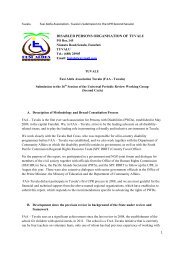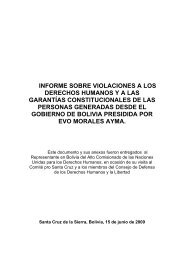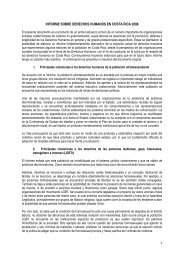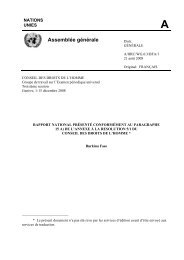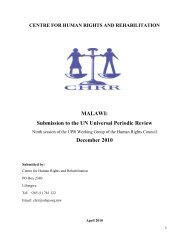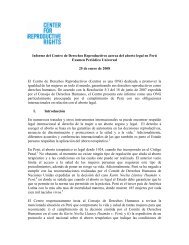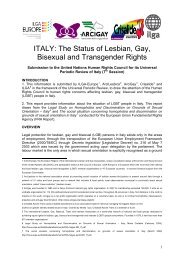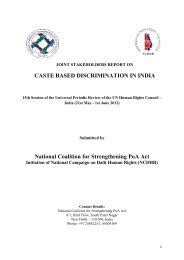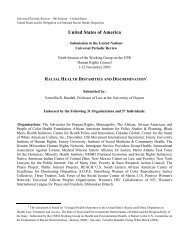Prison Needle Exchange: Lessons from a Comprehensive Review ...
Prison Needle Exchange: Lessons from a Comprehensive Review ...
Prison Needle Exchange: Lessons from a Comprehensive Review ...
Create successful ePaper yourself
Turn your PDF publications into a flip-book with our unique Google optimized e-Paper software.
Kyrgyzstan 218<br />
Summary<br />
Kyrgyzstan initiated a pilot prison needle exchange project in October 2002. In early 2003<br />
approval was given to expand needle exchange into all 11 Kyrgyz<br />
prisons. <strong>Needle</strong> exchanges are now operating in all prisons.<br />
HIV/AIDS, HCV, and IDU in Kyrgyzstan<br />
The sharp increase in intravenous drug use, coupled with a difficult<br />
social and economic situation, is creating a serious risk of an escalating<br />
HIV epidemic in Kyrgyzstan. As of June 2003 there were 825<br />
known cases of HIV or AIDS in the country, 82% of which were linked to injection drug<br />
use. 219 According to a December 2002 report published by UNAIDS and the WHO, a<br />
“[m]ore substantial spread of HIV is now also evident” in Kyrgyzstan. 220<br />
In Kyrgystan, needle<br />
exchanges are now<br />
operating in all prisons.<br />
HIV/AIDS, HCV, and IDU in Kyrgyz prisons<br />
In the 11 prisons in Kyrgyzstan, the number of identified prisoners living with HIV/AIDS<br />
has been steadily rising in recent years. In 2000 there were only three known cases of HIV<br />
in Kyrgyz prisons. In September 2001 this number had increased to 24, the majority being<br />
people who inject drugs. As of November 2002 there were more than 150 prisoners living<br />
with HIV/AIDS in Kyrgyzstan, 56% of all known cases in the country. 221<br />
Injection drug use and needle sharing are highly prevalent in Kyrgyz prisons. A survey<br />
conducted by a Kyrgyz non-governmental organization found that 100% of prison staff<br />
agreed that drugs are being used in the prisons. The survey also found that 90% of drug<br />
users in prisons said they shared needles and did not disinfect them. 222<br />
History of the response to HIV/AIDS,<br />
HCV, and IDU in Kyrgyz prisons<br />
HIV prevention programs in prisons started in 1998 before the first case of HIV was identified.<br />
Initially, the response consisted of education programs for prisoners and prison staff.<br />
In February 2001 the Main Directorate for Penalty Implementation (MDPI) and its<br />
Department of Correctional Institutions issued a “prikaz” (order) “on prevention of HIV/AIDS<br />
in the prison institutions of Kyrgyzstan” urging prisons to take steps to prevent the spread of<br />
HIV among prisoners. Based on this order, various HIV prevention and harm-reduction initiatives<br />
were implemented. These included the provision of condoms and disinfectants, HIV-prevention<br />
education for prisoners and staff, peer education, and voluntary HIV testing. Unofficial<br />
needle exchange was also initiated, specifically targeting those living with HIV/AIDS.<br />
Introduction of needle exchange/distribution programs<br />
The first program<br />
In October 2002 a pilot needle exchange project was introduced in <strong>Prison</strong> IK-47, a maximum-security<br />
institution. The project provides services for approximately 50 prisoners<br />
who exchange needles on a daily basis (the project averages approximately 50 exchanges<br />
per day).<br />
It was decided that exchanges should take place in a location where prisoners cannot be<br />
seen by guards; they therefore take place in the medical wards. Syringe exchange is provided<br />
in the narcological unit of the central prison hospital, and all prisoners have an opportu-<br />
<strong>Review</strong> of International Evidence 41



